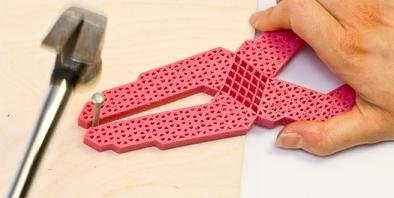Hasso-Plattner Institute Researchers Create Metamaterial Door Latch as Example of 3D Printing Versatility
 What I enjoy about 3D printing and so many of its innovations is that although we’ve certainly had a preview for decades of all sorts of magical looking futuristic inventions to come, with this new technology we truly do often see new products for real world applications today—and redesigns of age-old conveniences—that are unlike anything we ever imagined. Quite simply, most of us don’t have all day to sit in a design studio or a laboratory and fiddle within the realm of infinite concepts just waiting to be delved into, including the use of a host of alternative materials and tools. So when something comes along that looks completely different from the everyday items that we are used to—yes, it’s just a little mind-blowing—and while it might not be something absolutely necessary, it’s just plain fun to catch a glimpse of what brilliant researchers and makers around the world are up to. And of course, at 3DPrint.com, we are lucky enough to see that on a continual basis.
What I enjoy about 3D printing and so many of its innovations is that although we’ve certainly had a preview for decades of all sorts of magical looking futuristic inventions to come, with this new technology we truly do often see new products for real world applications today—and redesigns of age-old conveniences—that are unlike anything we ever imagined. Quite simply, most of us don’t have all day to sit in a design studio or a laboratory and fiddle within the realm of infinite concepts just waiting to be delved into, including the use of a host of alternative materials and tools. So when something comes along that looks completely different from the everyday items that we are used to—yes, it’s just a little mind-blowing—and while it might not be something absolutely necessary, it’s just plain fun to catch a glimpse of what brilliant researchers and makers around the world are up to. And of course, at 3DPrint.com, we are lucky enough to see that on a continual basis.
Consider all the things you do in a day, taking most of it for granted, moving on autopilot. Opening the door, using the doorknob, is a perfect example—and one that the researchers at the Hasso-Plattner Institute decided to use for showing how common objects can be improved through 3D printing. Not only that, they decided to simplify the doorknob by making it without any moving parts. That should get your attention, as aside from pushing an electronic button, one must wonder how they came up with such a thing. It’s all in the metamaterials, allowing for flexibility and ‘pre-defined directional movement.’
Operating as a latching mechanism made of fabric, this door handle has more of a 4D aspect to it as the materials adapt to the movement of the object when the user is either opening or closing the door. It’s also printed in one piece, offering up all the benefits of 3D printing, from self-sustainability in creation to affordability and speed.
The research team outlines their project, as well as discussing other items they have 3D printed, in ‘Metamaterial Mechanisms,’ authored by Alexandra Ion, Johannes Frohnhofen, Ludwig Wall, Robert Kovacs, Mirela Alistar, Jack Lindsay, Pedro Lopes, Hsiang-Ting Chen, and Patrick Baudisch.
“Our metamaterial door latch, for example, transforms the rotary movement of its handle into a linear motion of the latch,” state the researchers. “Our metamaterial Jansen walker consists of a single block of cells—that can walk. The key element behind our metamaterial mechanisms is a specialized type of cell, the only ability of which is to shear.”
The team has created a 3D editor which will allow users to create such objects made with metamaterials on their own, as they are able to use and place different kinds of cells, instilling functionality in their designs. As they state, “metamaterials are simple.” And due to the complexities of using multi-material 3D printers, the researchers decided to stick with technology using just one material. They state that while the doorknob is a useful product and should be easy to make, this new research, along with the editor, will allow users to combine this particular research with other metamaterial systems. The key is that they have to be created on a cube grid.
“Just to pick one example, we can make cells soft or hard by weakening their beams so as to allow the cells to compress more easily, or reinforcing their beams to make the cells stiffer.”
While their other metamaterial examples can ‘deform’ on their own, the door latch is part of a rigid system, via the door. Using areas of padded structure meant to be the recipient of force, they are able to connect the latch with the door and increase its stability.
“In case the handle is pushed up, the z-cells above the latch prevent the latch from moving outward,” state the researchers.
 This is obviously a starting point either for researchers, or for you as a maker working on creating more common objects and household tools. The 3D printed door handle is a great example of what can be done with the technology—and while you might not want this on your front door, there are certainly many other places where such a gentle opening and closing system would be quite appropriate, as well as building on some of the other designs the team from Hasso-Plattner Institute has created, such as the common tool depicted above. Discuss in the 3D Printed Door Handle forum at 3DPB.com.
This is obviously a starting point either for researchers, or for you as a maker working on creating more common objects and household tools. The 3D printed door handle is a great example of what can be done with the technology—and while you might not want this on your front door, there are certainly many other places where such a gentle opening and closing system would be quite appropriate, as well as building on some of the other designs the team from Hasso-Plattner Institute has created, such as the common tool depicted above. Discuss in the 3D Printed Door Handle forum at 3DPB.com.
Headquartered in Potsdam, the Hasso Plattner Institute (HPI) is known as a unique university in that they do not charge tuition for students attending classes to achieve Bachelor, Master and PhD degree programs in IT-Systems Engineering. All funding is donated through founder Professor Hasso Plattner, also the co-founder of SAP.
[Sources: Gizmodo; Creative Applications]
Subscribe to Our Email Newsletter
Stay up-to-date on all the latest news from the 3D printing industry and receive information and offers from third party vendors.
You May Also Like
Precision at the Microscale: UK Researchers Advance Medical Devices with BMF’s 3D Printing Tech
University of Nottingham researchers are using Boston Micro Fabrication‘s (BMF) 3D printing technology to develop medical devices that improve compatibility with human tissue. Funded by a UK grant, this project...
3D Printing Webinar and Event Roundup: April 21, 2024
It’s another busy week of webinars and events, starting with Hannover Messe in Germany and continuing with Metalcasting Congress, Chinaplas, TechBlick’s Innovation Festival, and more. Stratasys continues its advanced training...
3D Printing Webinar and Event Roundup: March 17, 2024
It’s another busy week of webinars and events, including SALMED 2024 and AM Forum in Berlin. Stratasys continues its in-person training and is offering two webinars, ASTM is holding a...
3D Printed Micro Antenna is 15% Smaller and 6X Lighter
Horizon Microtechnologies has achieved success in creating a high-frequency D-Band horn antenna through micro 3D printing. However, this achievement did not rely solely on 3D printing; it involved a combination...






























